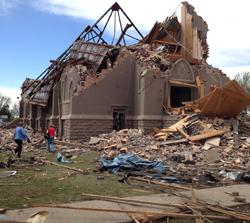
On Sunday, May 10, a tornado hit the small town of Delmont, South Dakota. Zion Lutheran Church, the tallest, most impressive landmark in Delmont, was destroyed. The Vogelpohl and Spaeth organ (II/9), much of which can be seen in the rubble pile in the accompanying photo, was totally laid waste. Although none of the pipes were salvageable, the console and chassis were picked out of the wreckage of the church and are in storage. The church has yet to decide what action they will be taking in building a new sanctuary.
The organ was built in 1912 and was an excellent example of Vogelpohl and Spaeth’s work complete with the original stenciled facade. The only change made to the organ over the years was the addition of an electric blower. The feeder bellows remained functional and were used on occasion.

